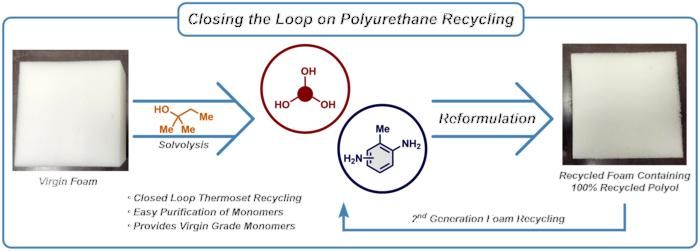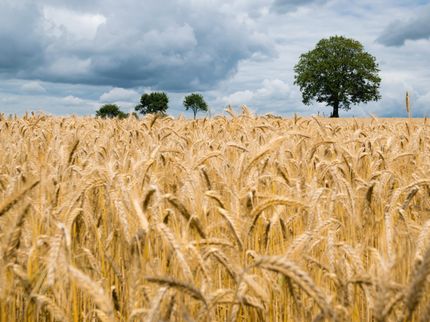Old mattresses made new
Simple chemistry can recycle polyurethane
Together with partners from industry, researchers from Aarhus University have now proven that simple chemistry can do more than just extract important raw materials from polyurethane foam – the most important component can also be reused again and again

Researchers at Aarhus University have invented and patented a method to break down the chemical bonds in a polyurethane foam mattress and extract its monomeric building blocks. The polyol (the molecule in the red circle) can then be reformulated into a new PU foam mattress.
Aarhus University
It created something of a stir when, back in 2022, researchers from Aarhus University announced a new and inexpensive way of breaking down polyurethane (PU) plastic into its original components, which can then be recycled into new PU material instead of ending up in landfills or incinerators.
Now, together with Plixxent A/S, Dan-Foam Aps and the Danish Technological Institute as part of the Danish RePURpose consortium, the same researchers have proven that the method can be used to tackle flexible foam polyurethane:
They have broken down approx. one-and-a-half kilos of foam mattress, extracted its main components and used one of them, polyol, as a raw material in a new piece of mattress. By replacing "fresh" polyol, which is primarily produced from crude oil, with polyol extracted from the old mattress, the researchers have replaced 64 per cent of the mattress, without impairing quality in any way.
They have also demonstrated that the process can be repeated several times. In other words, the polyol can be re-extracted from polyurethane foam and reused again.
Much needed solution
This takes us a step further towards a circular economy for flexible PU foam. And it is desperately needed.
The vast majority of global PU waste is deposited in landfills because it is difficult to recycle. PU cannot be melted, and for this reason it is not possible to simply mould it into new products like many other plastics.
The global market for PU was 24.7 million tonnes in 2021, and it is expected to exceed 29 million tonnes by 2029. The flexible PU foam used in mattresses accounts for about 30 per cent of the market.
PU is not only used in mattresses; it is a group of advanced plastic materials with many different properties and even more applications. It is also used in furniture, refrigerators, shoes, toys, paints, fillers, insulation, cars, wind turbines, aircraft and much more.
Requires waste control
The method developed and patented by the chemists at Aarhus University is called solvolysis, and breaks down the chemical bonds in PU by putting the material in a sort of pressure cooker with hot tert-amyl alcohol and a little caustic potash.
However, the researchers do not expect that this process can be used for the entire PU market. The different types of PU are too different.
"Our technique can push society towards a circular economy for PU mattresses. But if recycling is to put and end to landfilling and incineration, industry and society need full control of waste streams. The problem is that each manufacturer of PU-based materials has its own unique recipe," says Assistant Professor Steffan Kvist Kristensen from the Interdisciplinary Nanoscience Center (iNANO) at Aarhus University, who is a co-author of the study.
Original publication
Other news from the department science

Get the chemical industry in your inbox
By submitting this form you agree that LUMITOS AG will send you the newsletter(s) selected above by email. Your data will not be passed on to third parties. Your data will be stored and processed in accordance with our data protection regulations. LUMITOS may contact you by email for the purpose of advertising or market and opinion surveys. You can revoke your consent at any time without giving reasons to LUMITOS AG, Ernst-Augustin-Str. 2, 12489 Berlin, Germany or by e-mail at revoke@lumitos.com with effect for the future. In addition, each email contains a link to unsubscribe from the corresponding newsletter.
Most read news
More news from our other portals
Last viewed contents
Synthetic Batteries for the Energy Revolution - Redox-flow battery based on organic polymers and water presented

New procedure for better thermoplastics - New insights thanks to nano imaging and spectroscopy at the IRIS beamline of BESSY II
List_of_anaesthetic_drugs




























































